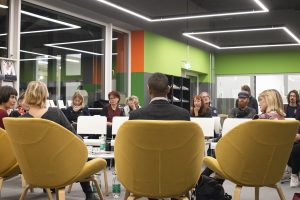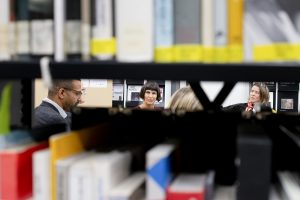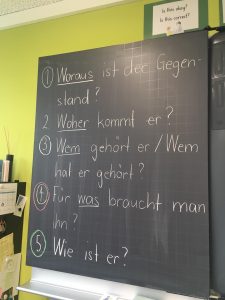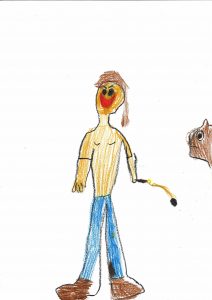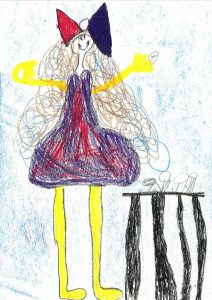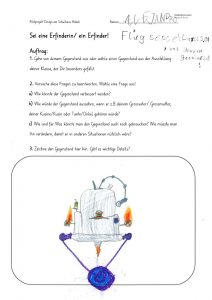Summary
STITCH-ED collaborated with the local school “Hübeli” for design workshop with students from grade four. The Hübeli school is a public primary school offering programs for grade one to six. Approx. 35 students participated in three design workshops, which were carried out in September 2019. Both, the head of the School Hübeli, Benno Gut, and Communication officer of the Community of Emmen, André Gassmann strongly supported us in this process.
Apart from the workshops STITCH-ED Switzerland included a public exhibition at the premises of the Lucerne School of Art and Design and a public podium discussion.
Detailed Process Overview
Workshop I: Creativity & Imagination (02 September 2019)
On 2 September the STITCH-ED team in Switzerland held a first design workshop, which aimed at inspiring creativity and imagination.
Exercise A consisted in inquiring into objects by way of asking questions: Students were introduced to inquiring their environment systematically by ways of asking questions about concrete objects we had brought with us – such as an antique broches, a horse whip or a bell from porcelain. The following questions were offered as entry point: “What are the component of the object?”, “What is it made of?”, What is its origin?”, and “Who did it belong to?”, “What can it be used for?”
Exercise B consisted in imagining the owner of the object could look like – and drawing a picture of this person. As a final step students were encouraged to look for an object they, themselves could bring to class. Then, as a homework task, they were asked to write a fictional story around the object – e.g. about the secret past of the object or about former owner.
Workshop II: Students as inventors (09 September 2019)
We started the second workshop by sharing the fictional stories in a marketplace approach. This meant that the first half of the class sat at their table with the objects and stories, while the second half of the class was free to wander in the class room to listen to the stories. Then students were invited to become inventors – e.g. changing, adapting or re-inventing their object to match an another persons needs. This led to A4-sketches of new objects. In an extra session the fictional stories were recorded with the students to become part of the final exhibition.
Workshop III: Creating prototypes (13 September 2019)
For the third workshop the students were invited to visit the Lucerne School of Art and Design. As an introduction we were given a tour around the premises by Nadia Müller from the LUASA workshop team. She introduced the young students to the variety of workshops at the school and gave examples for how they are used by the design students. Then, we settled in what is known as the LUASA 3D workshop and grouped around tables. By engaging with cardboard, paper, clay and a variety of textiles, the students familiarised themselves with the characteristics of the different types of material. Then we introduced and discussed the concept of prototypes, as a first or preliminary version of a product, from which further ideas and improvement can be developed. The students then moved on to create their own individual prototypes that would demonstrate the ideas from their sketches.
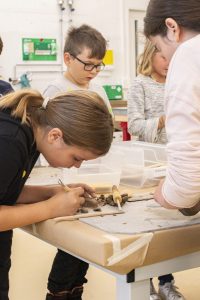
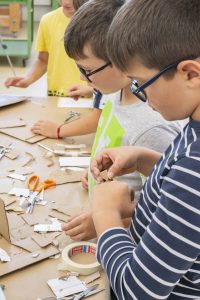
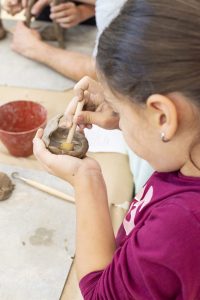
STITCH-ED Exhibition (09 Nov – 15 Nov 2019)
The public exhibition at the LUASA main entry hall provided space to share project impressions and create awareness for the project within Lucerne School of Art and Design. It consisted of oversized posters for each workshop, text plates, audio stations (playing the stories authored by the students) and a large-size board exhibiting a variety of artefacts from the design workshops. The collaboration with the NID in Ahmedabad, India, was represented through a video slide show. The positive feedback from both students and lecturers throughout the week-long exhibition demonstrated the interest in the project initiative around craft as problem-solving approach at primary schools, which was seen as a much-needed discussion.
The professionally designed and implemented exhibition went beyond what is typically known in the school context and allowed celebrating the project collaboration and the craft approach. The exhibition was opened on November 9, by the Head of the Hübeli School, Benno Gut. For the opening most students had shown up together with the entire family and LUASA was represented through the project team and the head of the LUASA workshops team, Beatrice Alves. During refreshments everyone was given the opportunity to visit the exhibition and share individual stories and experiences. Thus, the exhibition provided a unique experience for everyone involved.
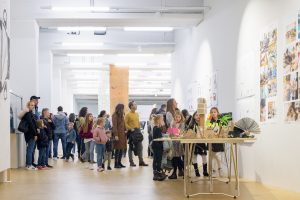

STITCH-ED Public Podium (13 November 2019)
A public podium with representatives from research, local authorities and business was held in the LUASA library during the STITCH-ED exhibition. It took place on took November 13, 2019. The following representatives from research, business and local authorities participated in the STITCH-ED public public podium: Brahim Aakti, Head of Educational Dpt. in Emmen, Nadja Rohrer, local Trade Association Emmen, Andrea Bachmann, Schindler Elevators, Mònica Gaspar, LUASA researcher.
The podium provided space to share perspectives and critically discuss project results. It became clear that business and local authorities both value the tangible project approach, and highlighted the significance of finding new ways of creating bridges between different educational sectors, business, schools, and universities. The meaning and use of craft and design for a digitally transformed society was both highlighted and debated. The discussion showed that the development of a common understanding and a common approach to craft, design and transformation remains to be developed – and is simultaneously much needed.
